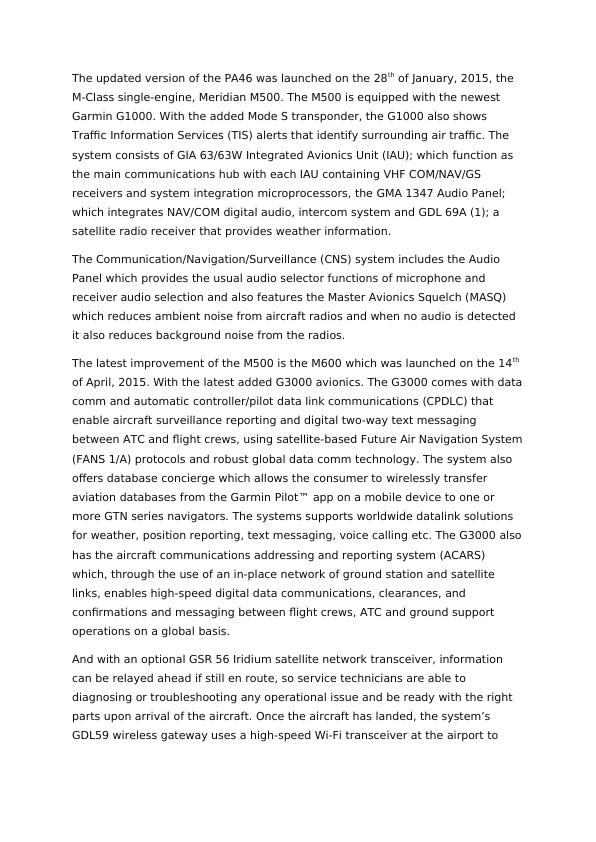Air Traffic Management - PDF
Added on 2021-04-23
5 Pages1633 Words60 Views
Current State of Art:With commercial air traffic expected to double within the next 15 years, the air traffic management is required to shift to a more accessible system; a digital system that can observe and control the increased air traffic. This system is known as the Unmanned Traffic Management (UTM). Through UTM, it is predictedthat civil aviation authorities (CAAs) and Air Navigation Service Provider (ANSPs),will be able to make real-time information regarding airspace constraints and flight intents available to UAS operators directly or through a UTM service provider (ICAO, 2016). The unmanned aircraft system operator would then be responsible for handling its operations without receiving air traffic control (ATC) services from the Air Navigation Service Provider ANSP. In the future, primary means of communication will be through a distributed network of highly automated systems rather than between a pilot and air traffic controllers.Benefits of the UTM system include:• Continued safety of all air traffic, manned and unmanned;• Safety of persons on the ground;• Complex low-level UA operations;• Ongoing support of technological advancements;• Evaluation of security and environmental risks; and• Provision for a global, harmonized framework for low-level UTM.Evolution and Improvements of the communication systems:PA46 – 500TP was launched in 2001. Fitted with the Garmin GNS-530 combined VHF Omnidirectional Radio (VOR)/ Instrument landing system localiser (LOC)/Global Positioning System (GPS) navcoms handle all the aircrafts navigation and communication functions. The TSO-certified system has a 2280-channel capacity comm and 200-channel ILS/ VOR with localiser and glideslope. The GNS 530 contains detailed data on the 25 nearest airports, VORs, non-directional beacon (NDBs), intersections and user-created waypoints within 200 nautical mile (NM) from the current position of the aircraft. The system also displays the five nearest Air Traffic Control, Flight information region centres (ARTCC/FIR) and Flight Service Station (FSS) points of communication. The GNS 530 features a digitally-tuned VHF COM radio and operates in the aviation voice band, between 118.000 to 136.975 megahertz (MHz). The COM radio also features an automatic squelch to reject many localized noise sources.

The updated version of the PA46 was launched on the 28th of January, 2015, the M-Class single-engine, Meridian M500. The M500 is equipped with the newest Garmin G1000. With the added Mode S transponder, the G1000 also shows Traffic Information Services (TIS) alerts that identify surrounding air traffic. The system consists of GIA 63/63W Integrated Avionics Unit (IAU); which function as the main communications hub with each IAU containing VHF COM/NAV/GS receivers and system integration microprocessors, the GMA 1347 Audio Panel; which integrates NAV/COM digital audio, intercom system and GDL 69A (1); a satellite radio receiver that provides weather information.The Communication/Navigation/Surveillance (CNS) system includes the Audio Panel which provides the usual audio selector functions of microphone and receiver audio selection and also features the Master Avionics Squelch (MASQ) which reduces ambient noise from aircraft radios and when no audio is detected it also reduces background noise from the radios.The latest improvement of the M500 is the M600 which was launched on the 14thof April, 2015. With the latest added G3000 avionics. The G3000 comes with datacomm and automatic controller/pilot data link communications (CPDLC) that enable aircraft surveillance reporting and digital two-way text messaging between ATC and flight crews, using satellite-based Future Air Navigation System(FANS 1/A) protocols and robust global data comm technology. The system also offers database concierge which allows the consumer to wirelessly transfer aviation databases from the Garmin Pilot™ app on a mobile device to one or more GTN series navigators. The systems supports worldwide datalink solutions for weather, position reporting, text messaging, voice calling etc. The G3000 alsohas the aircraft communications addressing and reporting system (ACARS) which, through the use of an in-place network of ground station and satellite links, enables high-speed digital data communications, clearances, and confirmations and messaging between flight crews, ATC and ground support operations on a global basis.And with an optional GSR 56 Iridium satellite network transceiver, information can be relayed ahead if still en route, so service technicians are able to diagnosing or troubleshooting any operational issue and be ready with the right parts upon arrival of the aircraft. Once the aircraft has landed, the system’s GDL59 wireless gateway uses a high-speed Wi-Fi transceiver at the airport to

End of preview
Want to access all the pages? Upload your documents or become a member.
